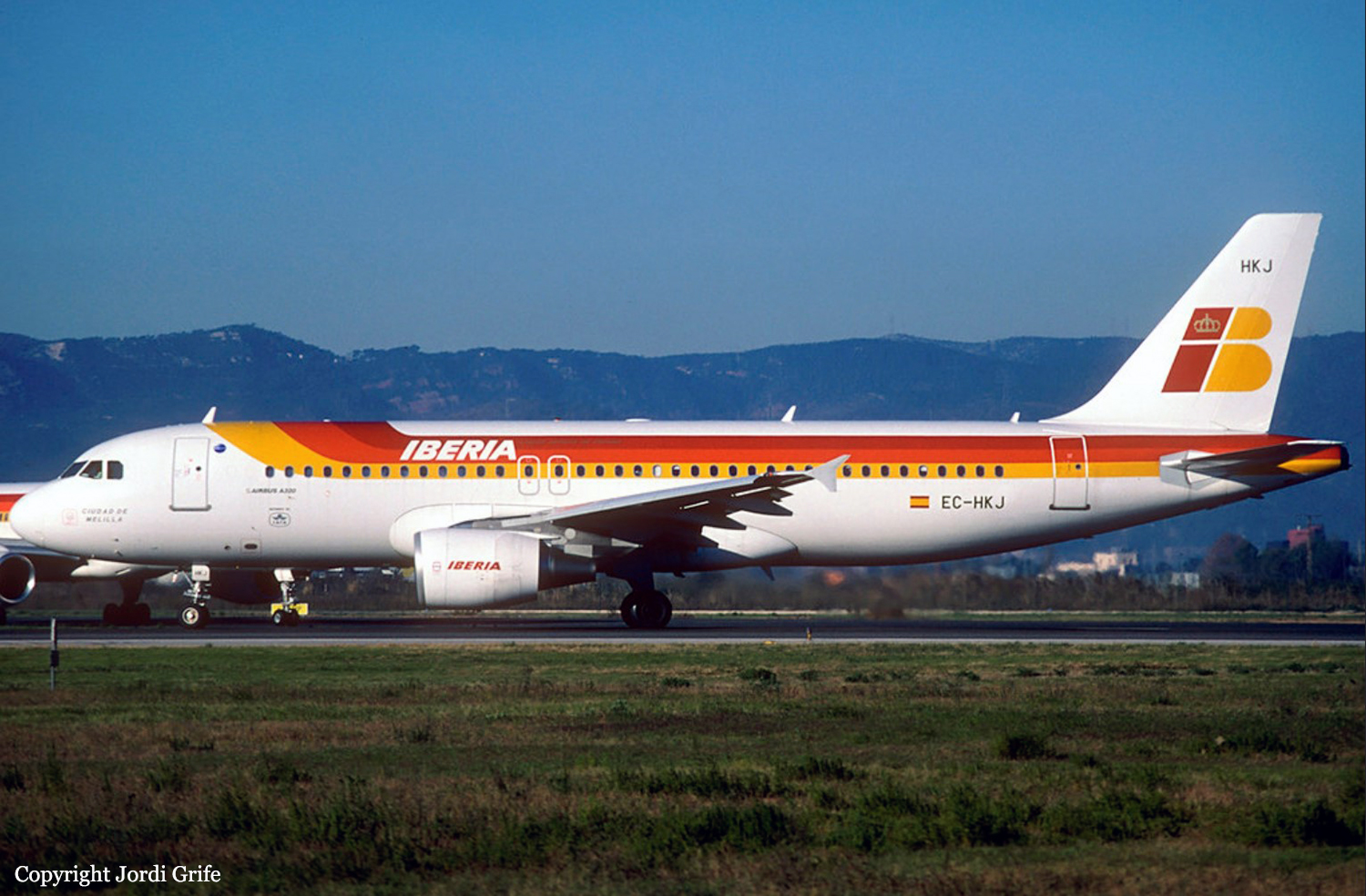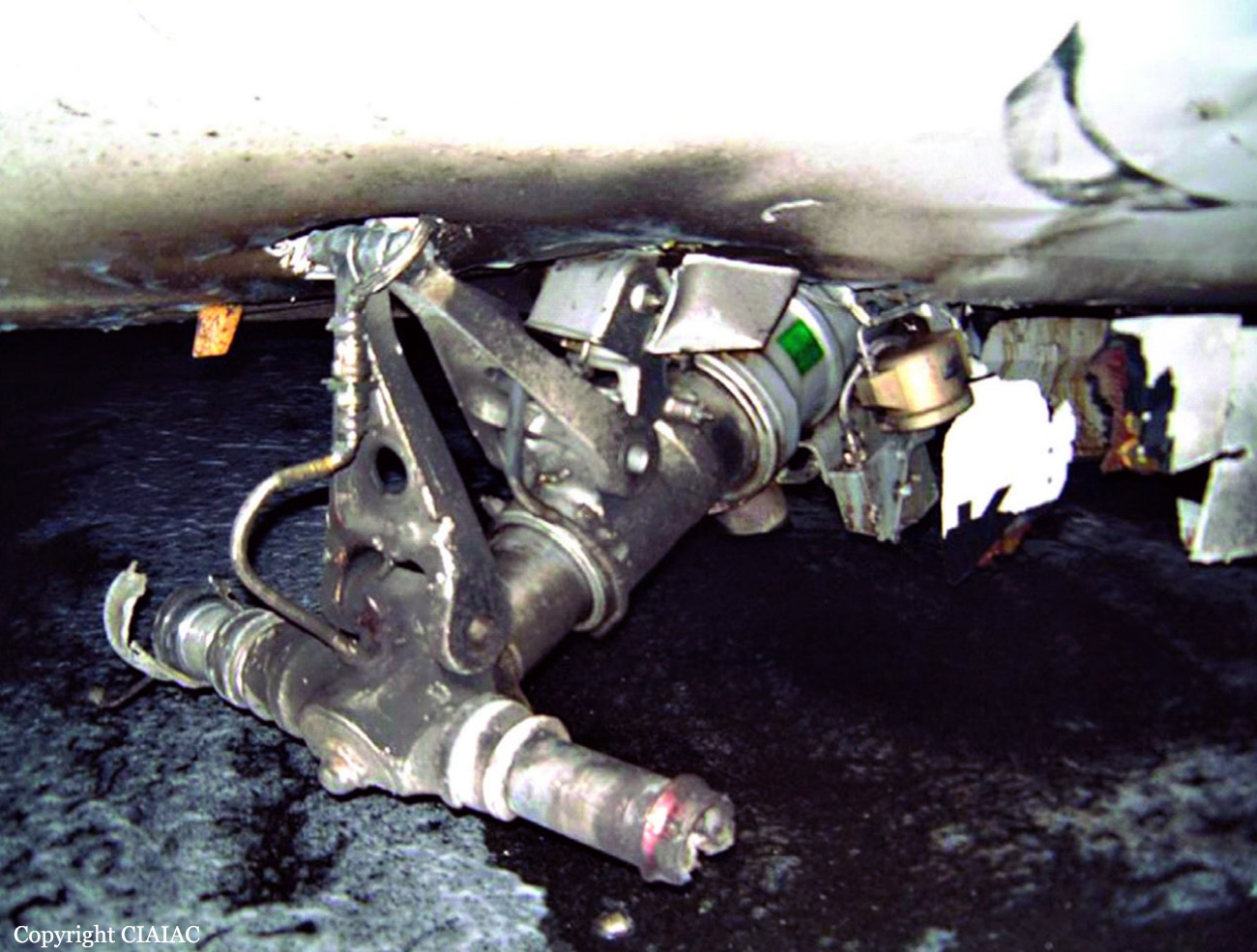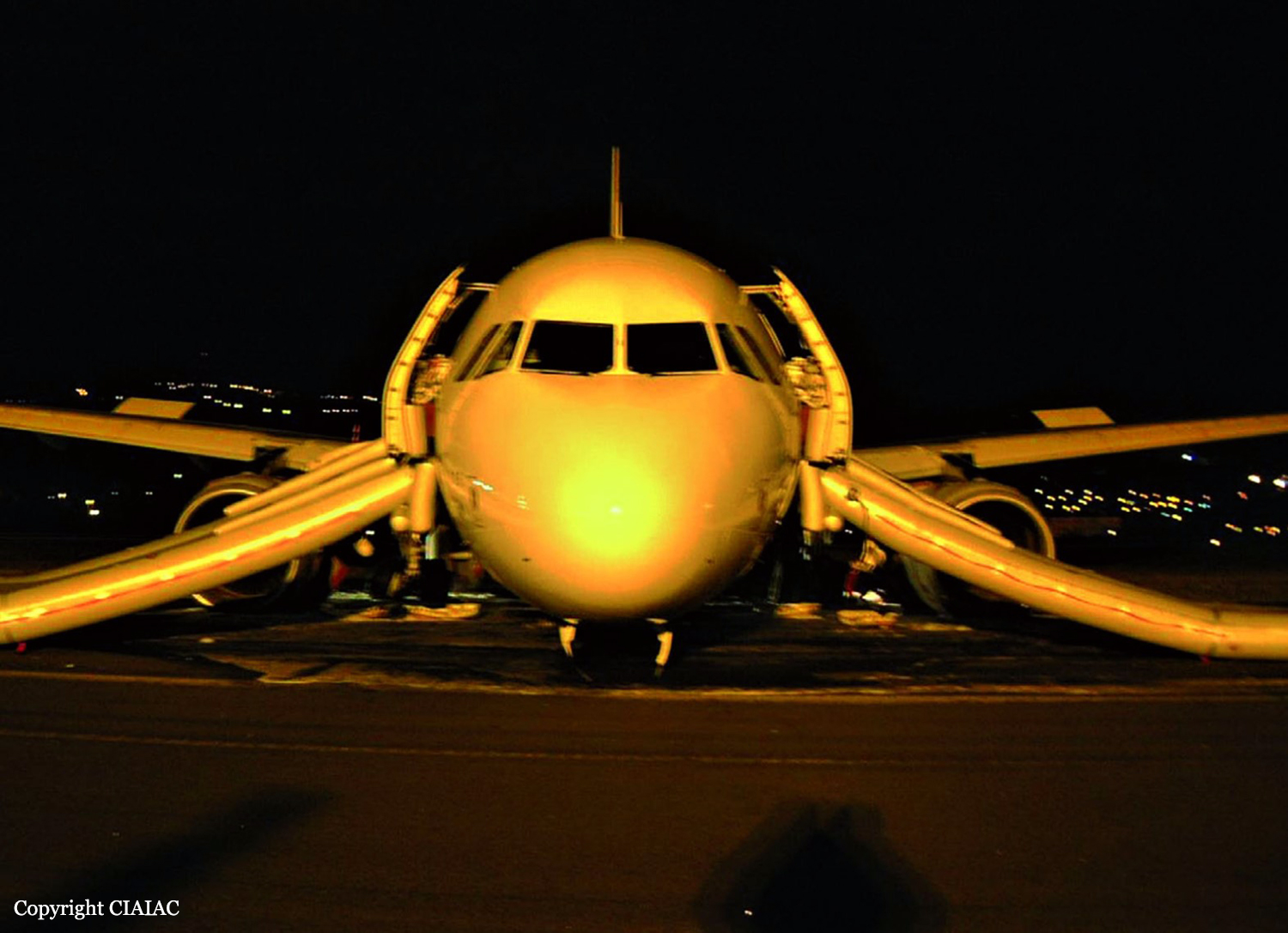Zone
Crash of a Boeing 737-406 in Barcelona
Date & Time:
Nov 28, 2004 at 1850 LT
Registration:
PH-BTC
Survivors:
Yes
Schedule:
Amsterdam – Barcelona
MSN:
25424
YOM:
1992
Flight number:
KL1673
Crew on board:
6
Crew fatalities:
Pax on board:
140
Pax fatalities:
Other fatalities:
Total fatalities:
0
Captain / Total hours on type:
5414.00
Copilot / Total hours on type:
1543
Aircraft flight hours:
31756
Aircraft flight cycles:
22156
Circumstances:
At 16:46 KLM Flight 1673 departed Amsterdam for Barcelona. Upon rotation from runway 18L the aircraft suffered a bird strike. A bird collided with the nose gear. The gear was retracted normally and there was no abnormal indication in the cockpit. The crew reported the impact to the ATC and the flight to Barcelona continued normally. The aircraft touched down on Barcelona's runway 25R. After touchdown of the nose landing gear, the aircraft started deviating to the left of the runway centreline. The veering to the left continued and the aircraft left the paved surface of the runway and went through an area of soft sand where some construction works were being carried out. The nose landing gear leg collapsed rearwards and the left main landing gear leg detached from its fittings shortly before the aircraft came to a stop close to the edge of a rain drainage canal. The final position of the aircraft was at a longitudinal distance of approximately 1606 m from runway 25R threshold, and at a lateral distance of approximately 84 m from the runway centreline.
Probable cause:
It is considered that the accident probably happened because during the takeoff a bird strike broke one of the cables of the nose wheel steering system of the aircraft and jammed the other, which made that the nose wheels were rotated to the left during landing, causing a veering to the left that could not be arrested by full rudder deflection as the aircraft decelerated. The subsequent application of brakes and other actions by the crew could not avoid that the aircraft went outside the runway surface. The damages to the aircraft were increased by the condition of the runway strip due to the airport construction works. Contributing to the breaking of the cable was the fact that it was severely worn locally. The wear could be traced back to the incorrect application of grease to the cable system during maintenance. Despite the training and experience of the flight crew, they were unable to quickly recognize the possible cause of the deviation of the aircraft and to keep the aircraft on the runway.
Final Report:
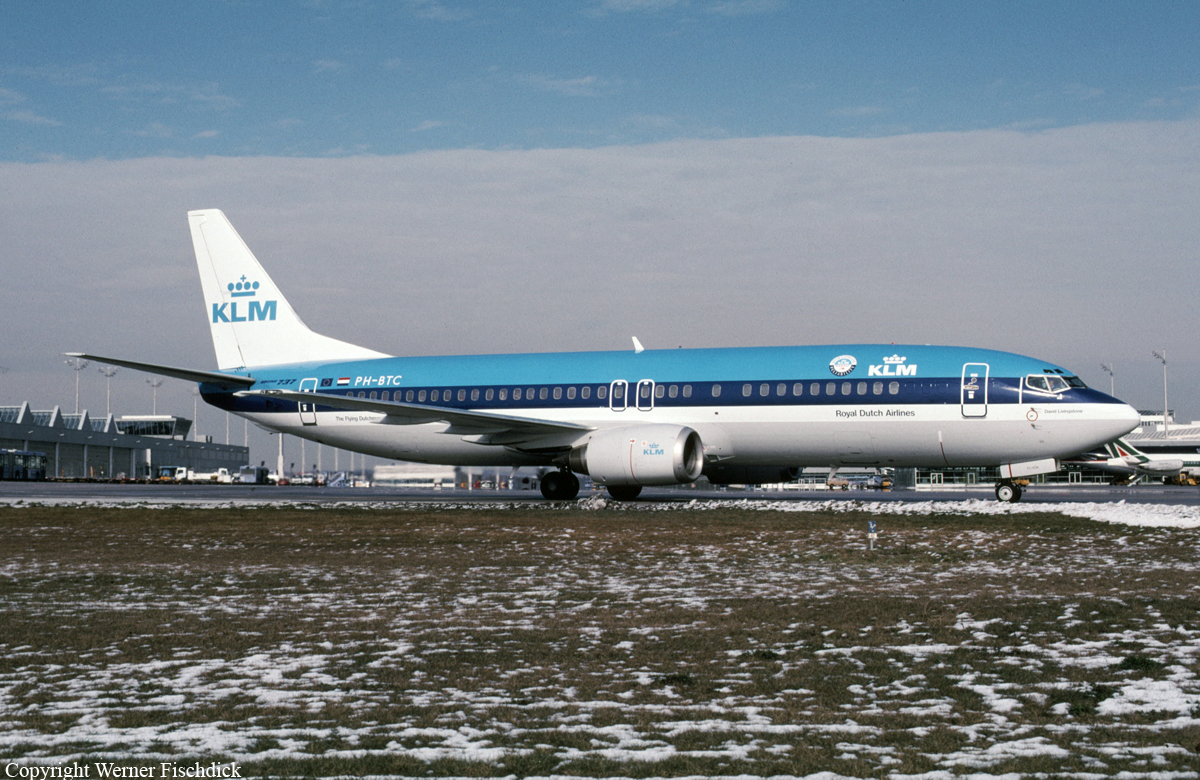

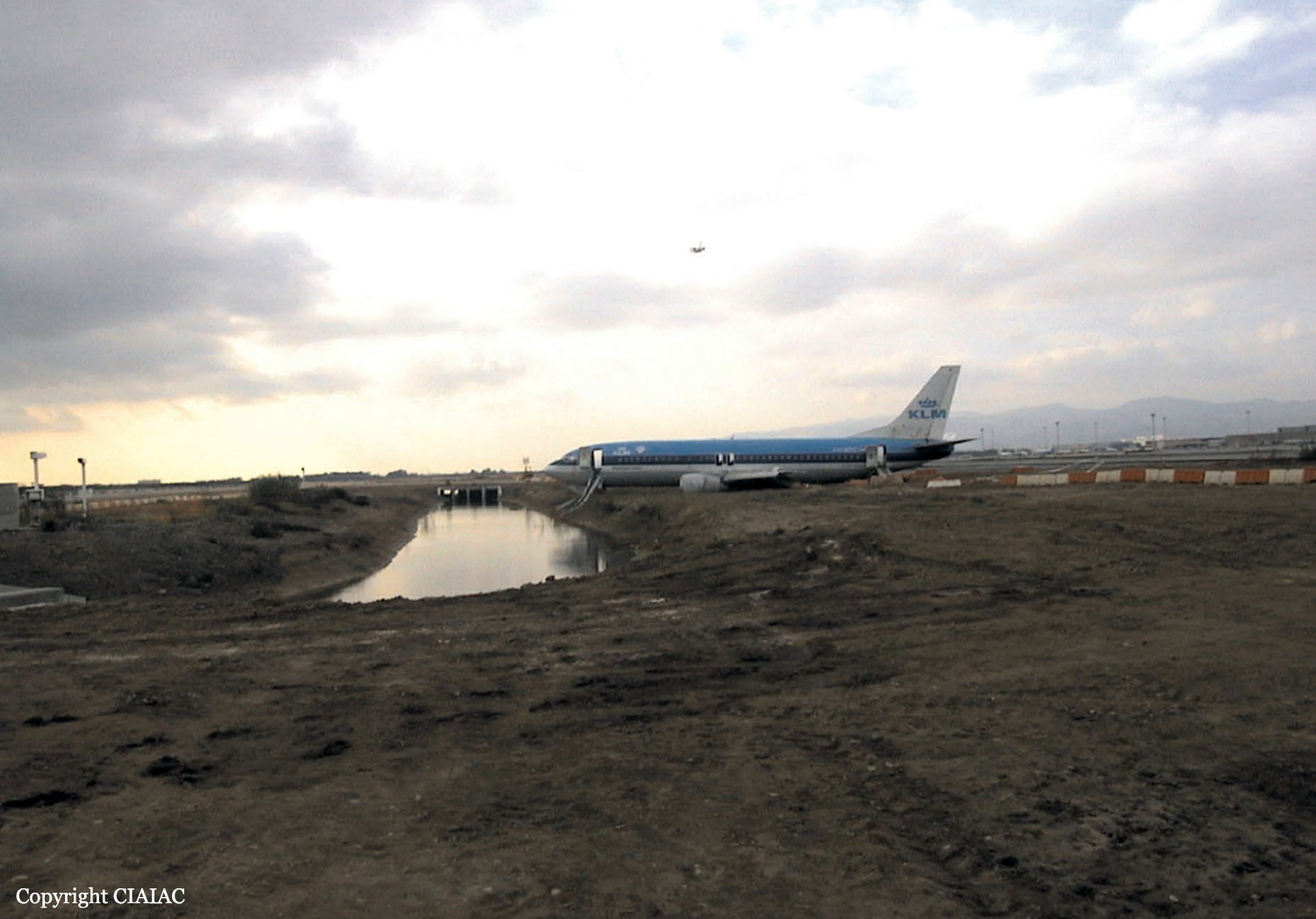
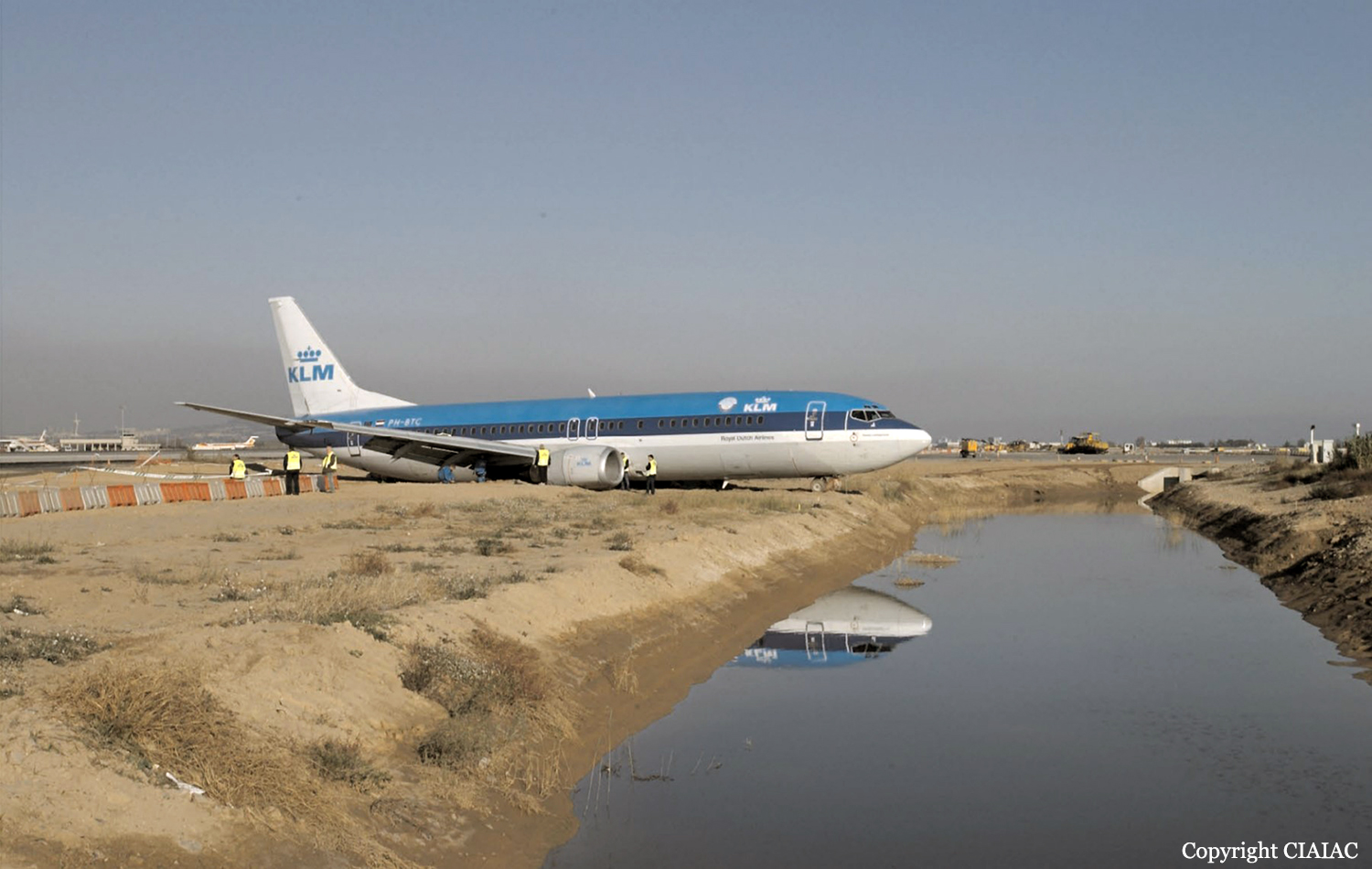
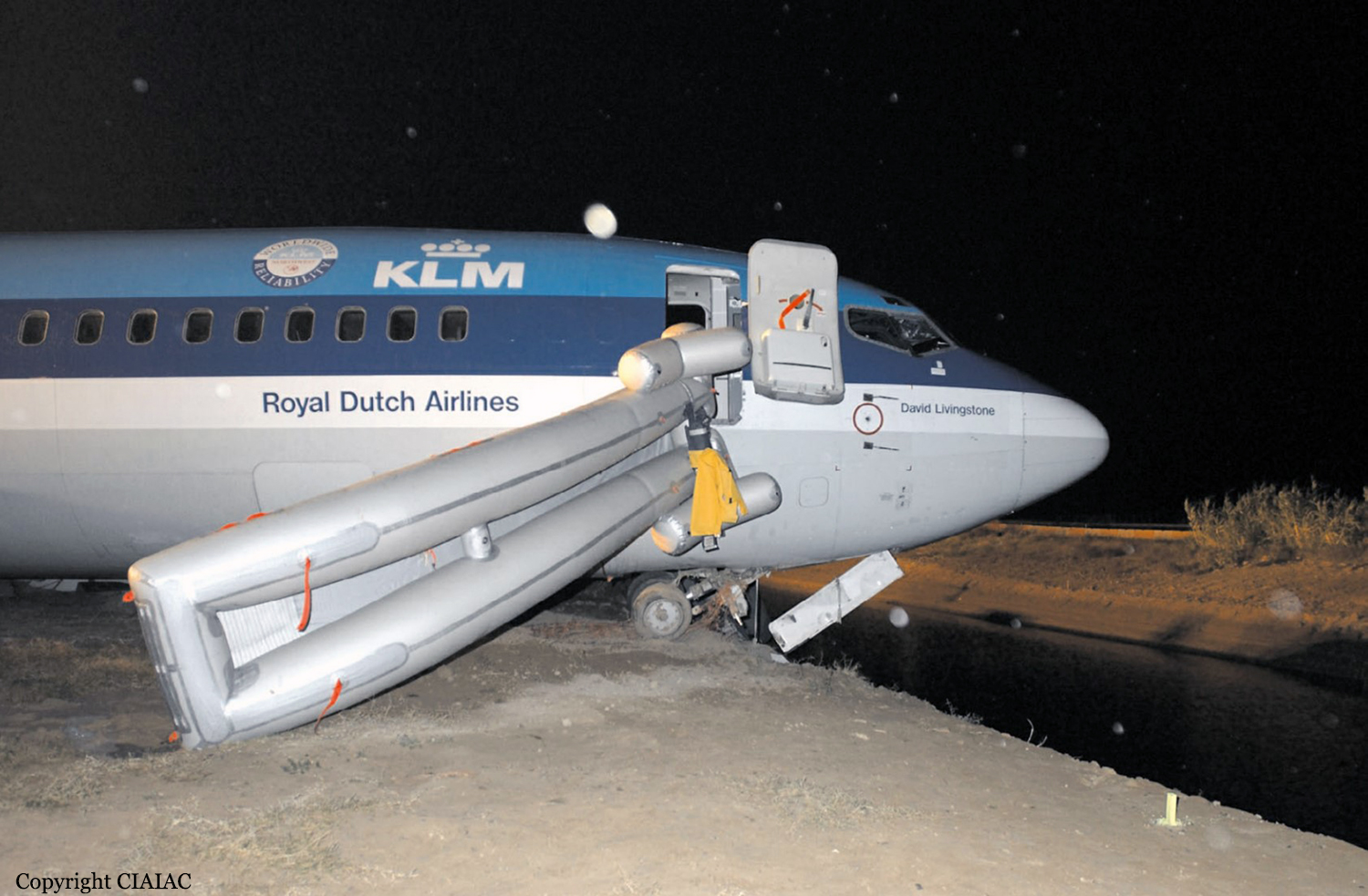
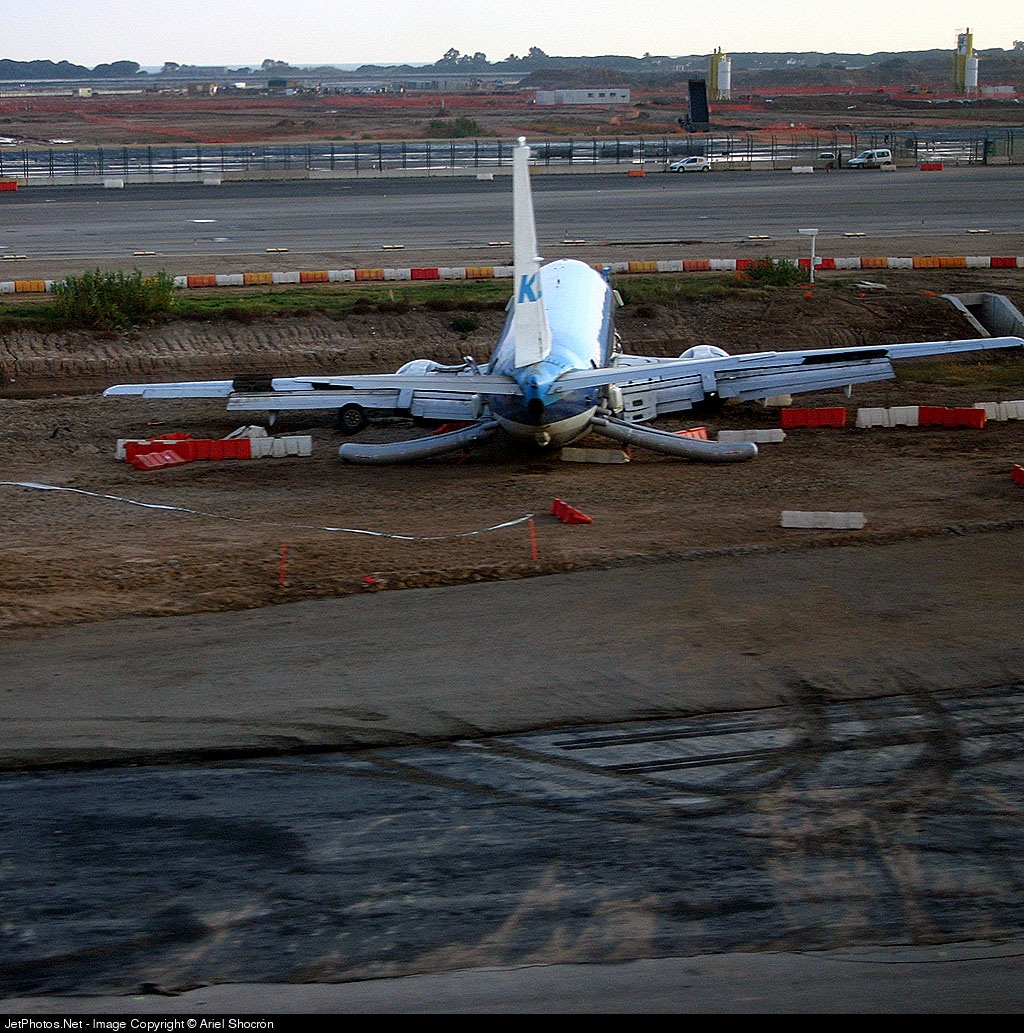
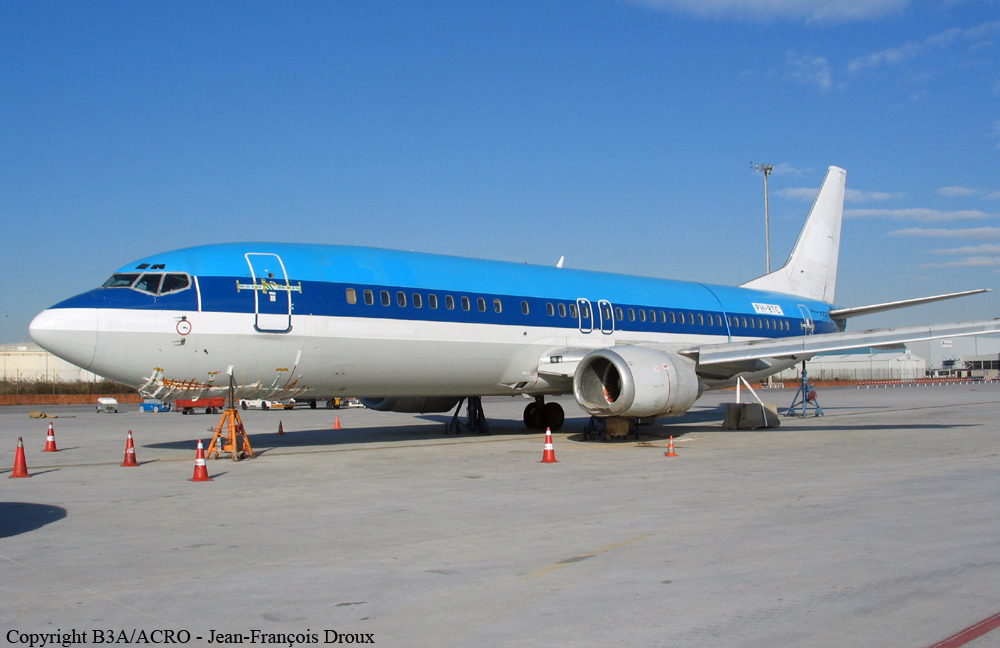

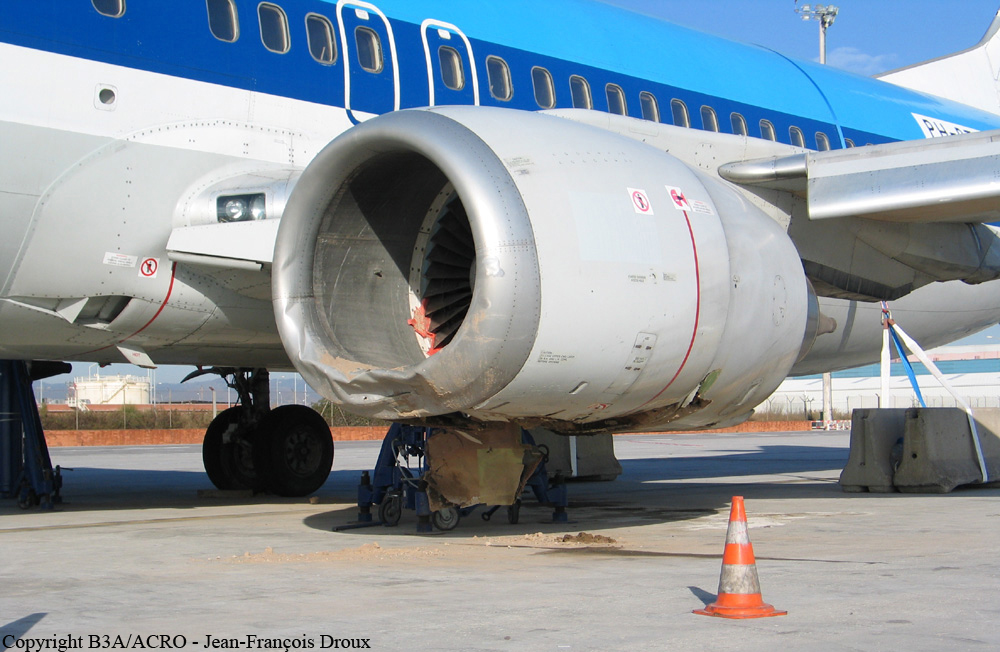

Crash of a Swearingen SA226TC Metro II in Reus
Date & Time:
Jan 31, 2004 at 1800 LT
Registration:
EC-HCU
Survivors:
Yes
Schedule:
Reus - Barcelona
MSN:
TC-390
YOM:
1981
Crew on board:
2
Crew fatalities:
Pax on board:
0
Pax fatalities:
Other fatalities:
Total fatalities:
0
Captain / Total hours on type:
2700.00
Copilot / Total hours on type:
360
Circumstances:
The crew was completing a positioning flight from Reus to Barcelona for maintenance purposes. During take off roll on runway 07, at a speed of 80 knots, the nose gear collapsed. The aircraft slid on its nose for few dozen metres before coming to rest on the runway. Both pilots escaped uninjured while the aircraft was damaged beyond repair.
Probable cause:
The nose gear folded because the lever was in the gear up position. The lever was in that position either due to the failure of the crew to carry out the checklists in full, in the event that the aircraft was delivered to them with the gear lever in the gear retracted position, or inadvertent action on the gear lever at some point between the last check by the crew and the moment of the accident.
Final Report:

Crash of a Cessna 500 Citation I/SP in Zurich
Date & Time:
Apr 7, 2003 at 1212 LT
Registration:
EC-HFA
Survivors:
Yes
Schedule:
Barcelona - Zurich
MSN:
500-0209
YOM:
1974
Crew on board:
1
Crew fatalities:
Pax on board:
2
Pax fatalities:
Other fatalities:
Total fatalities:
0
Captain / Total hours on type:
111.00
Aircraft flight hours:
13309
Aircraft flight cycles:
14054
Circumstances:
The aircraft took off at 1000LT from Barcelona (LEBL) on a private flight to Zurich (LSZH). The flight took place under instrument flight rules. Using radar vectors, EC-HFA was cleared at 1205 LT for an approach on the runway 14 instrument landing system (ILS). In the final approach phase, the aircraft entered a snow shower. The aircraft touched down on the grass about 700 metres before the runway threshold and skidded in a wide right turn in the direction of the threshold of runway 16. The aircraft was badly damaged. The three occupants were unharmed.
Probable cause:
The accident is attributable to the fact that the pilot, with insufficient visual references, continued his final approach below the minimum and the aircraft collided with the ground approximately 700 metres before the threshold of runway 14.
The following factors contributed to the accident:
• unsatisfactory flying qualification on the aircraft type involved in the accident.
• distraction by the passenger during the entire approach and at the decision height.
The following factors contributed to the accident:
• unsatisfactory flying qualification on the aircraft type involved in the accident.
• distraction by the passenger during the entire approach and at the decision height.
Final Report:


Crash of a Tupolev TU-154M in Überlingen: 69 killed
Date & Time:
Jul 1, 2002 at 2335 LT
Registration:
RA-85816
Survivors:
No
Schedule:
Ufa - Moscow - Barcelona
MSN:
95A1006
YOM:
1995
Flight number:
BTC2937
Crew on board:
9
Crew fatalities:
Pax on board:
60
Pax fatalities:
Other fatalities:
Total fatalities:
69
Captain / Total hours on type:
4918.00
Copilot / Total hours on type:
4317
Aircraft flight hours:
10788
Circumstances:
On 1 July 2002 at 21:35:32 hrs a Tupolev TU-154M on its flight from Moscow-Domodedovo /Russia to Barcelona/ Spain and a Boeing B757-200, which was on a flight from Bergamo /Italy to Brussels /Belgium, collided near the town of Ueberlingen (Lake Constance) in a dark night; the in-flight visibility at the flight level concerned was 10 km and more. Both airplanes impacted the ground north of the town of Ueberlingen. A larger number of witnesses had become aware of the accident by explosive noises, a prolonged roaring and rumbling as well as reflections of fire. Many of them saw pieces of debris burning while falling from the sky. The histories of the flights were reconstructed on the basis of the evaluation of the airborne flight data recorders (FDR) and cockpit voice recorders (CVR) and of the TCAS data stored in the airplanes, the radio communications between the Swiss Air Traffic Control Centre (ACC Zurich) and the crews of the Tupolev TU-154M and the Boeing B757-200 stored on the ground and the ground radar data recorded by the Swiss Air Navigation Services.
Boeing B757-200:
During the whole month of June 2002 both pilots, the pilot-in-command (PIC) and the copilot, had flown together as a crew. Several times they flew the route Bahrain - Bergamo - Brussels -
Bahrain. The last flight prior to this flight cycle was conducted on 28 June 2002 on the route Brussels – Bahrain. Prior to this flight the crew was off duty for 75 hours. They checked in at 11:50 hrs in Bahrain. At 13:30 hrs the airplane departed from Bahrain airport (OBBI) for a cargo flight to Brussels EBBR) with one intermediate stop at Bergamo (LIME). Only the two pilots were aboard the aircraft. The landing at Bergamo airport took place at 19:10 hrs after a flight time of 05 hours 40 minutes. In Bergamo, the airplane was refuelled, unloaded and reloaded with cargo. Take-off to continue the flight to Brussels was at 21:06 hrs. The airplane was flown by the copilot (PF). The flight was conducted under instrument flight rules (IFR). The flight plan (FPL) included the following information relevant to the flight: Aerodrome of departure: LIME, scheduled time of departure: 21:00 hrs, cruise speed: 463 kt, cruise level: FL 360, flight route: ABESI-UN851-TGO-UL608-LAMGO-UZ738-ANEKI-UZ917- BATTY, aerodrome of destination: EBBR, estimated flight time: 01:11 hrs, alternate aerodrome: EDDK (Cologne). At 21:21:50 hrs, the PIC contacted ACC Zurich on the frequency 128.050 MHz at FL 260 and in direct approach to the waypoint ABESI. At 21:21:56 hrs, the transponder code 7524 was assigned. With the identification of the airplane a clearance for a direct approach to the TANGO VOR as well as for a climb from FL 260 to FL 320 was given. The PIC requested to climb to FL 360, which was approved approximately four minutes later at 21:26:36 hrs. At 21:29:50 hrs the airplane reached this flight level, without the pilots reporting it. At 21:34:30 hrs the copilot handed over the control of the airplane to the PIC in order to go to the lavatory installed in a cubicle at the rear of the cockpit. At 21:34:31 hrs the PIC confirmed that he had taken over. At 21:34:42 hrs the airborne TCAS alarmed the crew about possibly conflicting traffic by a Traffic Advisory (TA): “traffic, traffic". After the TA the CVR recorded clicking noises. 14 seconds later (21:34:56 hrs) TCAS issued a Resolution Advisory (RA) “descend, descend". Approximately two seconds later the autopilot (AP) was switched off, the control column pushed and the thrust of the engines reduced. FDR data shows that the pitch was reduced from 2.5° to approximately 1.5° and the vertical acceleration lowered from about 1.0 g to 0.9 g. According to the FDR and the TCAS recordings the airplane had reached a rate of descent of 1500 ft/min 12 seconds after the autopilot had been switched off. At 21:35:05 hrs the CVR recorded via the cockpit area microphone the remark of the copilot “traffic right there“ which was confirmed by the PIC with “yes“. At 21:35:10 hrs, i.e. 14 seconds after the RA “descend, descend“, TCAS issued the advisory to increase the descent (“increase descent, increase descent“). At this time the copilot had returned to his work station and put on his headset. His reaction to the RA was recorded as "increase". Following this RA, the rate of descent was changed and reached approximately 2600 ft/min 10 seconds later. During the descent the pitch angle decreased to –1° and the powerplant thrust was reduced to approximately 1.2 (EPR). According to the CVR at 21:35:14 hrs a Master Caution Aural Warning is heard for two seconds. According to the FDR the autothrottle was switched off by the crew at 21:35:18 hrs. At 21:35:19 hrs the crew reported the “TCAS descent“ to ACC Zurich. Subsequently the copilot requested the PIC twice to descend. Once with the word “descend“ (21:35:26 hrs) and then by saying “descend hard“ (21:35:30 hrs). Approximately two seconds prior to the collision the control column was pushed fully forward. At 21:35:32 hrs the airplane flying a northern heading (MH = 004°) with a pitch angle of approximately – 2° and no bank angle collided with the TU154M at 34 890 ft.
Tupolev TU-154M:
The crew was off duty for 24 hours before take-off for the charter flight to Barcelona (LEBL). They checked in at 17:30 hrs. At 18:48 hrs the airplane departed from the airport Moscow-Domodedovo (UUDD). Nine crew members and 60 passengers were aboard the airplane. The flight was conducted under instrument flight rules (IFR) in accordance with the flight plan (FPL) filed. The FPL included the following information relevant to the flight: Aerodrome of departure: UUDD, planned time of departure: 18:30 hrs, cruise speed: 880 km/h, cruise level: 10 600 m, flight route: KLIMOVSK-KAMENKA-ZAKHAROVKA-R11-YUKHNOVB102-BAEVO/cruise speed: 470 kt, cruise level: FL 360, flight route: UL979-MATUS-UM984-BOLMU-UT43-STOCKERAU-UR23-SALZBURG-UL856-TRASADINGEN-Z69-OLBEN-UN869-OLRAK-UN855-PERPIGNAN-UB384-GIRONA-UB38-SABADELL, aerodrome of arrival: LEBL, estimated flight time: 04:20 hours, alternate aerodrome: LEGE (Girona). Five flight crew members were in the cockpit. The commander (under supervision) - who was the PF (Pilot flying) on this flight - occupied the left-hand seat in the cockpit. The right-hand seat was occupied by an instructor, who as a PNF (Pilot non flying) also conducted the radio communications. He was also the pilot-in-command (PIC). The seat of the flight navigator was between and slightly behind the pilots. The work station of the flight engineer was behind the instructor. A further pilot (copilot), who had no function on this flight, was on a vacant seat behind the commander. At 21:11:55 hrs - near Salzburg still over Austrian territory - the crew received the clearance from Vienna radar for a direct approach to the Trasadingen VOR at FL 360. At 21:16:10 hrs, the airplane entered German airspace and was controlled by Munich Radar. At 21:29:54 hrs, the crew was instructed by Munich to change over to ACC Zurich on 128.050 MHz. At 21:30:11 hrs and at FL 360 the PNF contacted ACC Zurich. At 21:30:33 hrs, ACC Zurich assigned the transponder code 7520 to the airplane, which was acknowledged 6 seconds later. For the time between about 21:33:00 hrs and 21:34:41 hrs the CVR recorded crew discussions concerning an airplane approaching from the left which was displayed on the vertical speed indicator (VSI/TRA) which is part of the TCAS. All flight crew members with the exception of the flight engineer were involved in these discussions. These recordings suggest that the crew strived to localize the other airplane as to its position and its flight level. At 21:34:36 hrs, the commander stated: “Here it is in sight“, and two seconds later: “Look here, it indicates zero“. During the time from 21:34:25 hrs to 21:34:55 hrs, the airplane turned at a bank angle of approximately 10° from a magnetic heading (MH) of 254° to 264°. At 21:34:42 hrs, TCAS generated a TA (“traffic, traffic“). The CVR recorded that both the PIC and the copilot called out “traffic, traffic“. At 21:34:49 hrs - i.e. seven seconds later - ACC Zurich instructed the crew to expedite descent to FL350 with reference to conflicting traffic (“...... descend flight level 350, expedite, I have crossing traffic“). While the controller was giving the instruction - the radio transmission took just under eight seconds - the PIC requested the PF to descend. At 21:34:56 hrs, the control column was pushed forward, the autopilot (pitch channel) was switched off and the powerplant thrust reduced to approximately 72 % (N1). FDR data shows a reduction of the pitch angle of the airplane from 0° to approximately –2.5° as well as a reduction of the vertical acceleration from approximately 1 g (normal acceleration of the earth near the airplane centre of gravity) to 0.8 g. The instruction to descend was not verbally acknowledged by the crew. At the same time (21:34:56 hrs) TCAS generated an RA (“climb, climb“). At 21:34:59 hrs, the CVR recorded the voice of the copilot stating: “It (TCAS) says (говорит): “climb“. The PIC replied: “He (ATC) is guiding us down“. The copilot's enquiring response: “descend?“ At 21:35:02 hrs, (six seconds after the RA “ climb, climb”) the PF pulled the control column. As a result, the rate of descent ceased to increase. The vertical acceleration rose from 0.75 g to 1.07 g. The engine thrust remained unchanged in conjunction with this control input (refer to Appendix 5a). At 21:35:03 hrs, the engine throttles were pulled back further. The discussion between the crew members was interrupted at 21:35:03 hrs by the controller instructing the crew once again to expedite descend to FL 350 (“... descend level 350, expedite descend“).This instruction was immediately acknowledged by the PNF. The controller then informed the crew about other flight traffic at FL 360 in the 2 o’clock position (“...Ya, … we have traffic at your 2 o’clock position now at 3-6-0“) and the PIC asked: “Where is it?“, the copilot answered: “Here on the left side!“. At the time, the rate of descent was approximately 1 500 ft/min. The voice of the flight navigator can be heard on the CVR saying:" It is going to pass beneath us!" while the controller was giving his last instruction. At 21:35:04 hrs the roll channel of the autopilot was switched off. At 21:35:05 hrs, the PF pushed the control column again and the rate of descent increased to more than 2 000 ft/min. From 21:35:07 hrs to 21:35:24 hrs the aircraft heading changed to the right from 264° to 274° MH. At 21:35:24 hrs TCAS issued an RA “increase climb“. The copilot commented this with the words: “It says ‘climb”! At the time of the RA „increase climb“, the FDR recorded a slow movement of the control column nose down leading to a change in pitch angle from –1° to approximately –2° and in a reduction in vertical acceleration. The descent rate was approximately 1800 ft/min (refer to Appendix 5b). Five seconds before the collision the control column was pulled back, associated with a minor increase of thrust levers setting. One second prior to the collision the pitch angle reached –1° and the vertical acceleration 1.1 g. During the last second before the collision the control column was pulled back abruptly and the thrust levers were pushed fully forward. At the time of the collision the pitch angle was 0°; the vertical acceleration was 1.4 g but the airplane was still in a descent. The airplane collided with a heading of 274° and a bank angle to the right of 10° with the Boeing B757-200 at 21:35:32 hrs at a flight level of 34 890 ft. After the collision, the TU154M rolled with increasing rate about the longitudinal axis to the left. Simultaneously with this rolling movement the extension of the aileron-spoiler on the right wing was recorded. Within approximately two seconds after the collision the pitch angle changed from 0° to -6° and the cabin differential pressure decreased within one second from 0.6 kg/cm2 to a value close to 0 kg/ cm2.
Boeing B757-200:
During the whole month of June 2002 both pilots, the pilot-in-command (PIC) and the copilot, had flown together as a crew. Several times they flew the route Bahrain - Bergamo - Brussels -
Bahrain. The last flight prior to this flight cycle was conducted on 28 June 2002 on the route Brussels – Bahrain. Prior to this flight the crew was off duty for 75 hours. They checked in at 11:50 hrs in Bahrain. At 13:30 hrs the airplane departed from Bahrain airport (OBBI) for a cargo flight to Brussels EBBR) with one intermediate stop at Bergamo (LIME). Only the two pilots were aboard the aircraft. The landing at Bergamo airport took place at 19:10 hrs after a flight time of 05 hours 40 minutes. In Bergamo, the airplane was refuelled, unloaded and reloaded with cargo. Take-off to continue the flight to Brussels was at 21:06 hrs. The airplane was flown by the copilot (PF). The flight was conducted under instrument flight rules (IFR). The flight plan (FPL) included the following information relevant to the flight: Aerodrome of departure: LIME, scheduled time of departure: 21:00 hrs, cruise speed: 463 kt, cruise level: FL 360, flight route: ABESI-UN851-TGO-UL608-LAMGO-UZ738-ANEKI-UZ917- BATTY, aerodrome of destination: EBBR, estimated flight time: 01:11 hrs, alternate aerodrome: EDDK (Cologne). At 21:21:50 hrs, the PIC contacted ACC Zurich on the frequency 128.050 MHz at FL 260 and in direct approach to the waypoint ABESI. At 21:21:56 hrs, the transponder code 7524 was assigned. With the identification of the airplane a clearance for a direct approach to the TANGO VOR as well as for a climb from FL 260 to FL 320 was given. The PIC requested to climb to FL 360, which was approved approximately four minutes later at 21:26:36 hrs. At 21:29:50 hrs the airplane reached this flight level, without the pilots reporting it. At 21:34:30 hrs the copilot handed over the control of the airplane to the PIC in order to go to the lavatory installed in a cubicle at the rear of the cockpit. At 21:34:31 hrs the PIC confirmed that he had taken over. At 21:34:42 hrs the airborne TCAS alarmed the crew about possibly conflicting traffic by a Traffic Advisory (TA): “traffic, traffic". After the TA the CVR recorded clicking noises. 14 seconds later (21:34:56 hrs) TCAS issued a Resolution Advisory (RA) “descend, descend". Approximately two seconds later the autopilot (AP) was switched off, the control column pushed and the thrust of the engines reduced. FDR data shows that the pitch was reduced from 2.5° to approximately 1.5° and the vertical acceleration lowered from about 1.0 g to 0.9 g. According to the FDR and the TCAS recordings the airplane had reached a rate of descent of 1500 ft/min 12 seconds after the autopilot had been switched off. At 21:35:05 hrs the CVR recorded via the cockpit area microphone the remark of the copilot “traffic right there“ which was confirmed by the PIC with “yes“. At 21:35:10 hrs, i.e. 14 seconds after the RA “descend, descend“, TCAS issued the advisory to increase the descent (“increase descent, increase descent“). At this time the copilot had returned to his work station and put on his headset. His reaction to the RA was recorded as "increase". Following this RA, the rate of descent was changed and reached approximately 2600 ft/min 10 seconds later. During the descent the pitch angle decreased to –1° and the powerplant thrust was reduced to approximately 1.2 (EPR). According to the CVR at 21:35:14 hrs a Master Caution Aural Warning is heard for two seconds. According to the FDR the autothrottle was switched off by the crew at 21:35:18 hrs. At 21:35:19 hrs the crew reported the “TCAS descent“ to ACC Zurich. Subsequently the copilot requested the PIC twice to descend. Once with the word “descend“ (21:35:26 hrs) and then by saying “descend hard“ (21:35:30 hrs). Approximately two seconds prior to the collision the control column was pushed fully forward. At 21:35:32 hrs the airplane flying a northern heading (MH = 004°) with a pitch angle of approximately – 2° and no bank angle collided with the TU154M at 34 890 ft.
Tupolev TU-154M:
The crew was off duty for 24 hours before take-off for the charter flight to Barcelona (LEBL). They checked in at 17:30 hrs. At 18:48 hrs the airplane departed from the airport Moscow-Domodedovo (UUDD). Nine crew members and 60 passengers were aboard the airplane. The flight was conducted under instrument flight rules (IFR) in accordance with the flight plan (FPL) filed. The FPL included the following information relevant to the flight: Aerodrome of departure: UUDD, planned time of departure: 18:30 hrs, cruise speed: 880 km/h, cruise level: 10 600 m, flight route: KLIMOVSK-KAMENKA-ZAKHAROVKA-R11-YUKHNOVB102-BAEVO/cruise speed: 470 kt, cruise level: FL 360, flight route: UL979-MATUS-UM984-BOLMU-UT43-STOCKERAU-UR23-SALZBURG-UL856-TRASADINGEN-Z69-OLBEN-UN869-OLRAK-UN855-PERPIGNAN-UB384-GIRONA-UB38-SABADELL, aerodrome of arrival: LEBL, estimated flight time: 04:20 hours, alternate aerodrome: LEGE (Girona). Five flight crew members were in the cockpit. The commander (under supervision) - who was the PF (Pilot flying) on this flight - occupied the left-hand seat in the cockpit. The right-hand seat was occupied by an instructor, who as a PNF (Pilot non flying) also conducted the radio communications. He was also the pilot-in-command (PIC). The seat of the flight navigator was between and slightly behind the pilots. The work station of the flight engineer was behind the instructor. A further pilot (copilot), who had no function on this flight, was on a vacant seat behind the commander. At 21:11:55 hrs - near Salzburg still over Austrian territory - the crew received the clearance from Vienna radar for a direct approach to the Trasadingen VOR at FL 360. At 21:16:10 hrs, the airplane entered German airspace and was controlled by Munich Radar. At 21:29:54 hrs, the crew was instructed by Munich to change over to ACC Zurich on 128.050 MHz. At 21:30:11 hrs and at FL 360 the PNF contacted ACC Zurich. At 21:30:33 hrs, ACC Zurich assigned the transponder code 7520 to the airplane, which was acknowledged 6 seconds later. For the time between about 21:33:00 hrs and 21:34:41 hrs the CVR recorded crew discussions concerning an airplane approaching from the left which was displayed on the vertical speed indicator (VSI/TRA) which is part of the TCAS. All flight crew members with the exception of the flight engineer were involved in these discussions. These recordings suggest that the crew strived to localize the other airplane as to its position and its flight level. At 21:34:36 hrs, the commander stated: “Here it is in sight“, and two seconds later: “Look here, it indicates zero“. During the time from 21:34:25 hrs to 21:34:55 hrs, the airplane turned at a bank angle of approximately 10° from a magnetic heading (MH) of 254° to 264°. At 21:34:42 hrs, TCAS generated a TA (“traffic, traffic“). The CVR recorded that both the PIC and the copilot called out “traffic, traffic“. At 21:34:49 hrs - i.e. seven seconds later - ACC Zurich instructed the crew to expedite descent to FL350 with reference to conflicting traffic (“...... descend flight level 350, expedite, I have crossing traffic“). While the controller was giving the instruction - the radio transmission took just under eight seconds - the PIC requested the PF to descend. At 21:34:56 hrs, the control column was pushed forward, the autopilot (pitch channel) was switched off and the powerplant thrust reduced to approximately 72 % (N1). FDR data shows a reduction of the pitch angle of the airplane from 0° to approximately –2.5° as well as a reduction of the vertical acceleration from approximately 1 g (normal acceleration of the earth near the airplane centre of gravity) to 0.8 g. The instruction to descend was not verbally acknowledged by the crew. At the same time (21:34:56 hrs) TCAS generated an RA (“climb, climb“). At 21:34:59 hrs, the CVR recorded the voice of the copilot stating: “It (TCAS) says (говорит): “climb“. The PIC replied: “He (ATC) is guiding us down“. The copilot's enquiring response: “descend?“ At 21:35:02 hrs, (six seconds after the RA “ climb, climb”) the PF pulled the control column. As a result, the rate of descent ceased to increase. The vertical acceleration rose from 0.75 g to 1.07 g. The engine thrust remained unchanged in conjunction with this control input (refer to Appendix 5a). At 21:35:03 hrs, the engine throttles were pulled back further. The discussion between the crew members was interrupted at 21:35:03 hrs by the controller instructing the crew once again to expedite descend to FL 350 (“... descend level 350, expedite descend“).This instruction was immediately acknowledged by the PNF. The controller then informed the crew about other flight traffic at FL 360 in the 2 o’clock position (“...Ya, … we have traffic at your 2 o’clock position now at 3-6-0“) and the PIC asked: “Where is it?“, the copilot answered: “Here on the left side!“. At the time, the rate of descent was approximately 1 500 ft/min. The voice of the flight navigator can be heard on the CVR saying:" It is going to pass beneath us!" while the controller was giving his last instruction. At 21:35:04 hrs the roll channel of the autopilot was switched off. At 21:35:05 hrs, the PF pushed the control column again and the rate of descent increased to more than 2 000 ft/min. From 21:35:07 hrs to 21:35:24 hrs the aircraft heading changed to the right from 264° to 274° MH. At 21:35:24 hrs TCAS issued an RA “increase climb“. The copilot commented this with the words: “It says ‘climb”! At the time of the RA „increase climb“, the FDR recorded a slow movement of the control column nose down leading to a change in pitch angle from –1° to approximately –2° and in a reduction in vertical acceleration. The descent rate was approximately 1800 ft/min (refer to Appendix 5b). Five seconds before the collision the control column was pulled back, associated with a minor increase of thrust levers setting. One second prior to the collision the pitch angle reached –1° and the vertical acceleration 1.1 g. During the last second before the collision the control column was pulled back abruptly and the thrust levers were pushed fully forward. At the time of the collision the pitch angle was 0°; the vertical acceleration was 1.4 g but the airplane was still in a descent. The airplane collided with a heading of 274° and a bank angle to the right of 10° with the Boeing B757-200 at 21:35:32 hrs at a flight level of 34 890 ft. After the collision, the TU154M rolled with increasing rate about the longitudinal axis to the left. Simultaneously with this rolling movement the extension of the aileron-spoiler on the right wing was recorded. Within approximately two seconds after the collision the pitch angle changed from 0° to -6° and the cabin differential pressure decreased within one second from 0.6 kg/cm2 to a value close to 0 kg/ cm2.
Probable cause:
The following immediate causes have been identified:
• The imminent separation infringement was not noticed by ATC in time. The instruction for the TU-154M to descend was given at a time when the prescribed separation to the B757-
200 could not be ensured anymore.
• The TU-154M crew followed the ATC instruction to descend and continued to do so even after TCAS advised them to climb. This manoeuvre was performed contrary to the generated TCAS RA.
The following systemic causes have been identified:
• The integration of ACAS/TCAS II into the system aviation was insufficient and did not correspond in all points with the system philosophy. The regulations concerning ACAS/TCAS published by ICAO and as a result the regulations of national aviation authorities, operational and procedural instructions of the TCAS manufacturer and the operators were not standardised, incomplete and partially contradictory.
• Management and quality assurance of the air navigation service company did not ensure that during the night all open workstations were continuously staffed by controllers.
• Management and quality assurance of the air navigation service company tolerated for years that during times of low traffic flow at night only one controller worked and the other one retired to rest.
• The imminent separation infringement was not noticed by ATC in time. The instruction for the TU-154M to descend was given at a time when the prescribed separation to the B757-
200 could not be ensured anymore.
• The TU-154M crew followed the ATC instruction to descend and continued to do so even after TCAS advised them to climb. This manoeuvre was performed contrary to the generated TCAS RA.
The following systemic causes have been identified:
• The integration of ACAS/TCAS II into the system aviation was insufficient and did not correspond in all points with the system philosophy. The regulations concerning ACAS/TCAS published by ICAO and as a result the regulations of national aviation authorities, operational and procedural instructions of the TCAS manufacturer and the operators were not standardised, incomplete and partially contradictory.
• Management and quality assurance of the air navigation service company did not ensure that during the night all open workstations were continuously staffed by controllers.
• Management and quality assurance of the air navigation service company tolerated for years that during times of low traffic flow at night only one controller worked and the other one retired to rest.
Final Report:
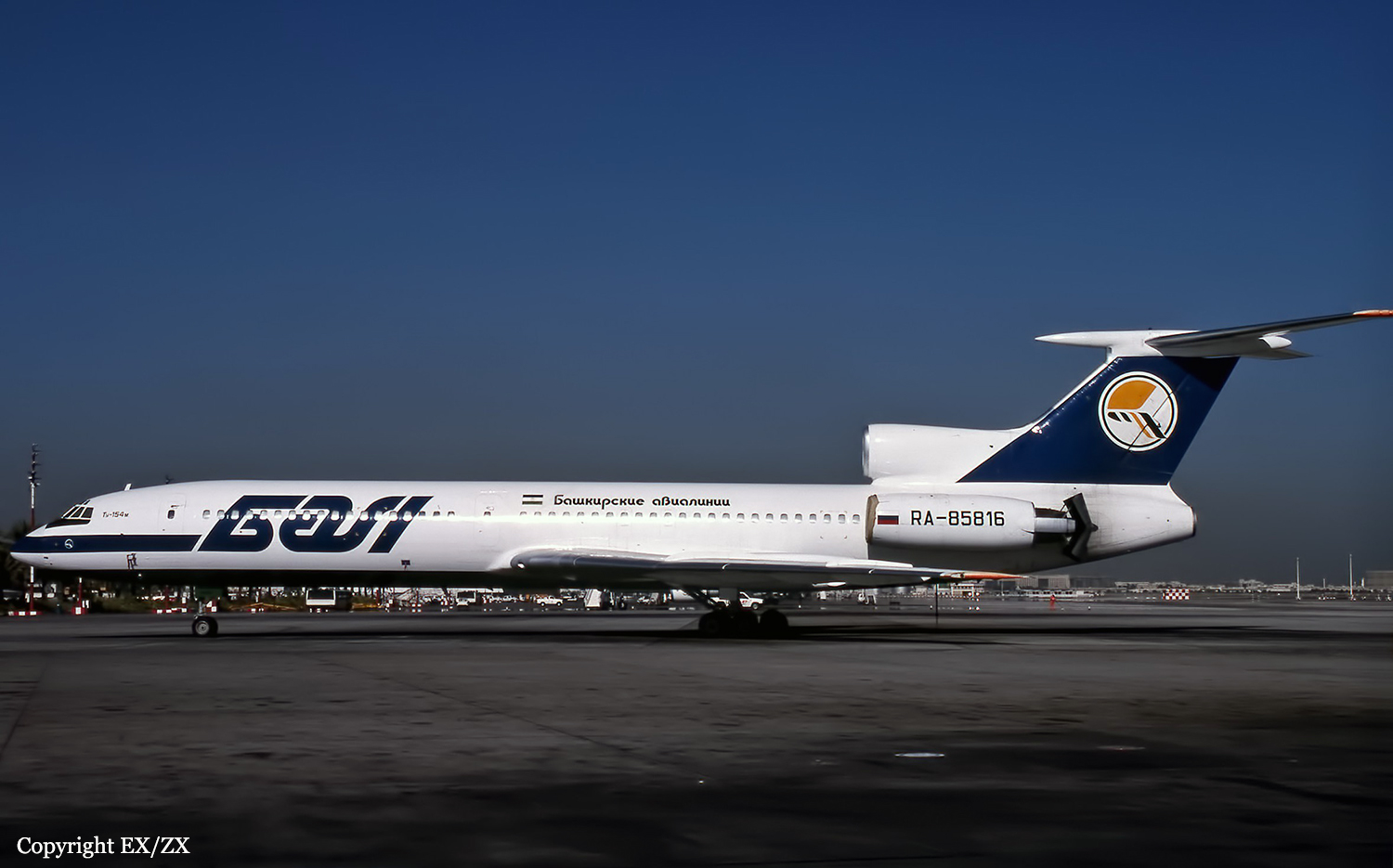
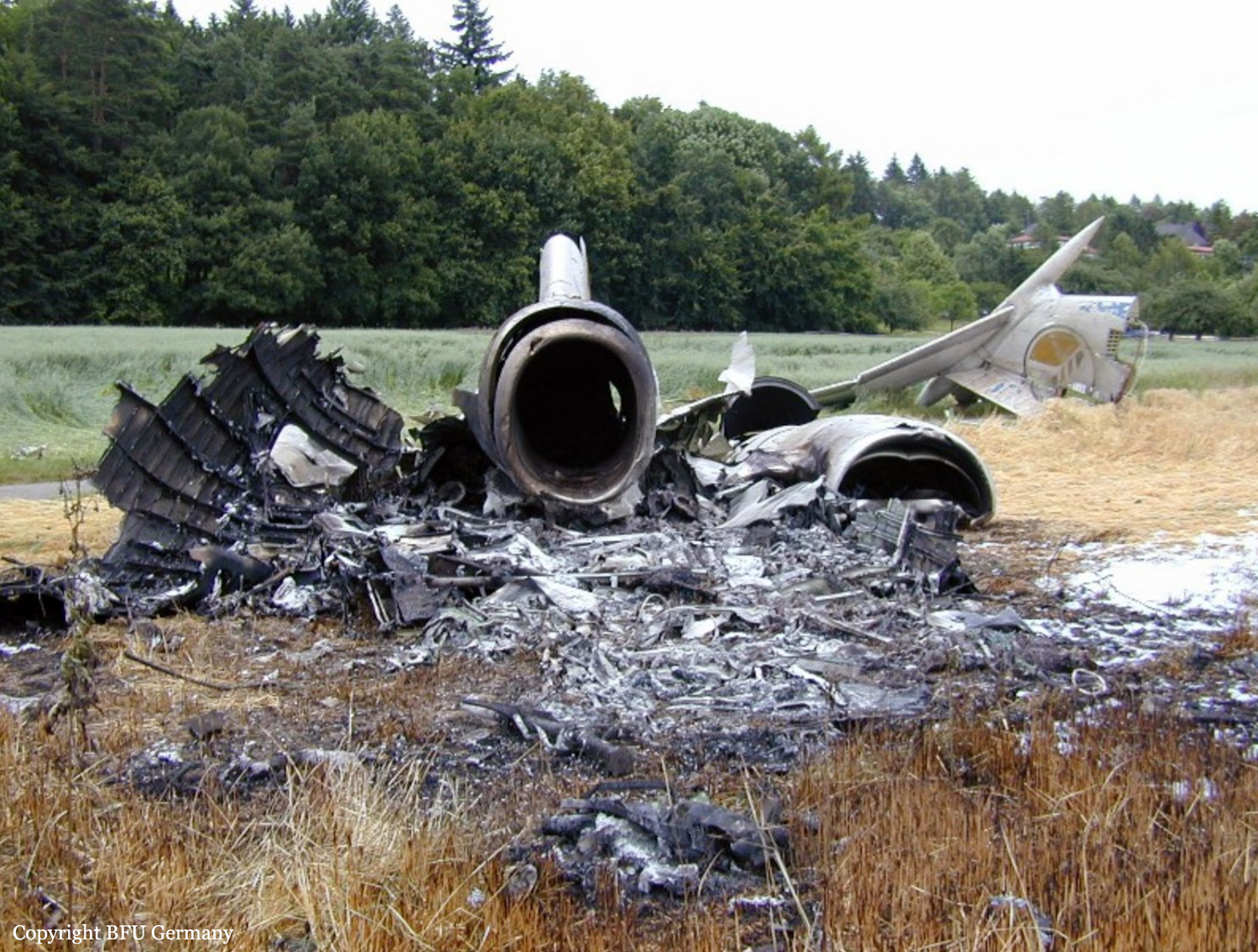
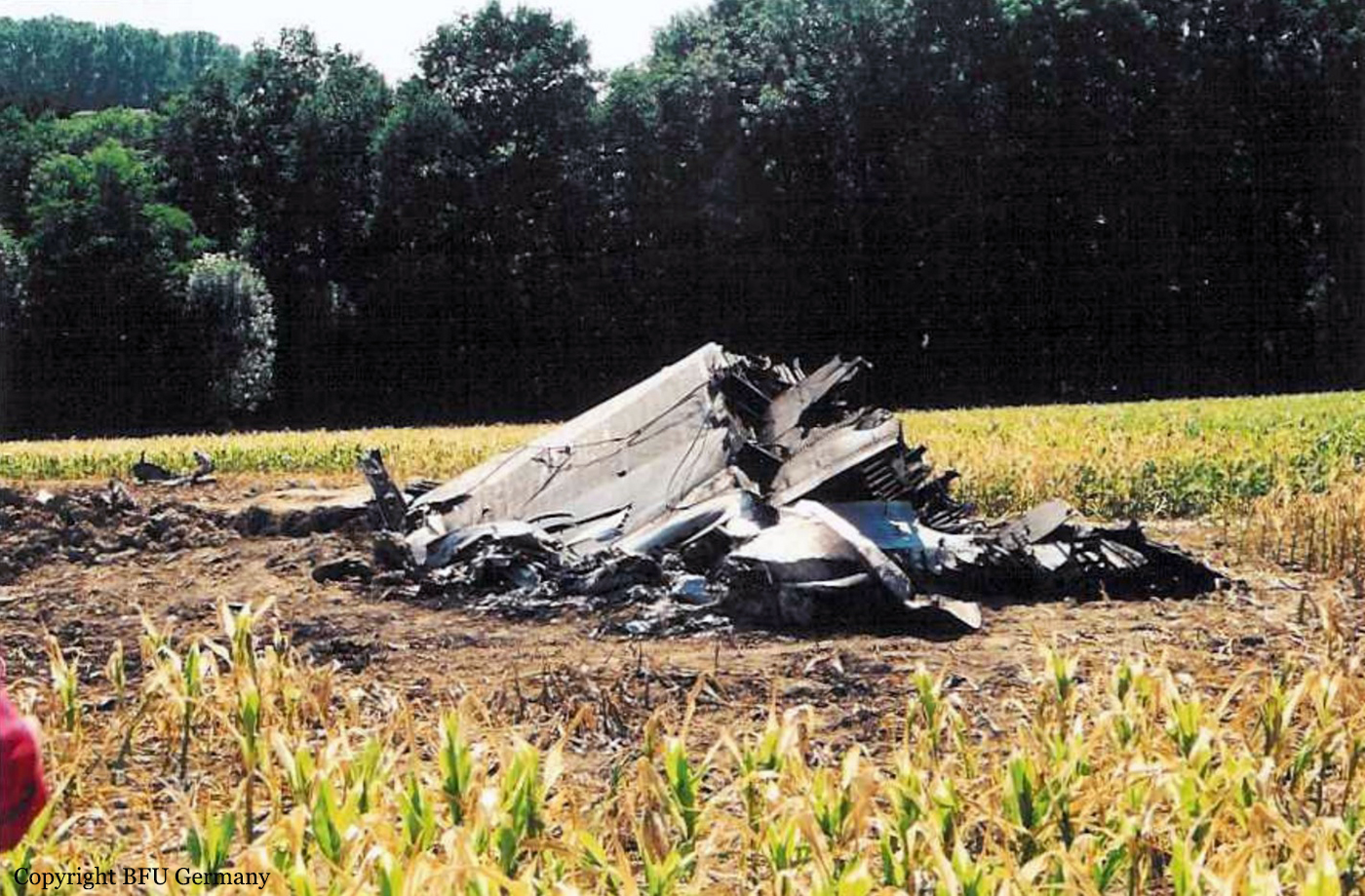

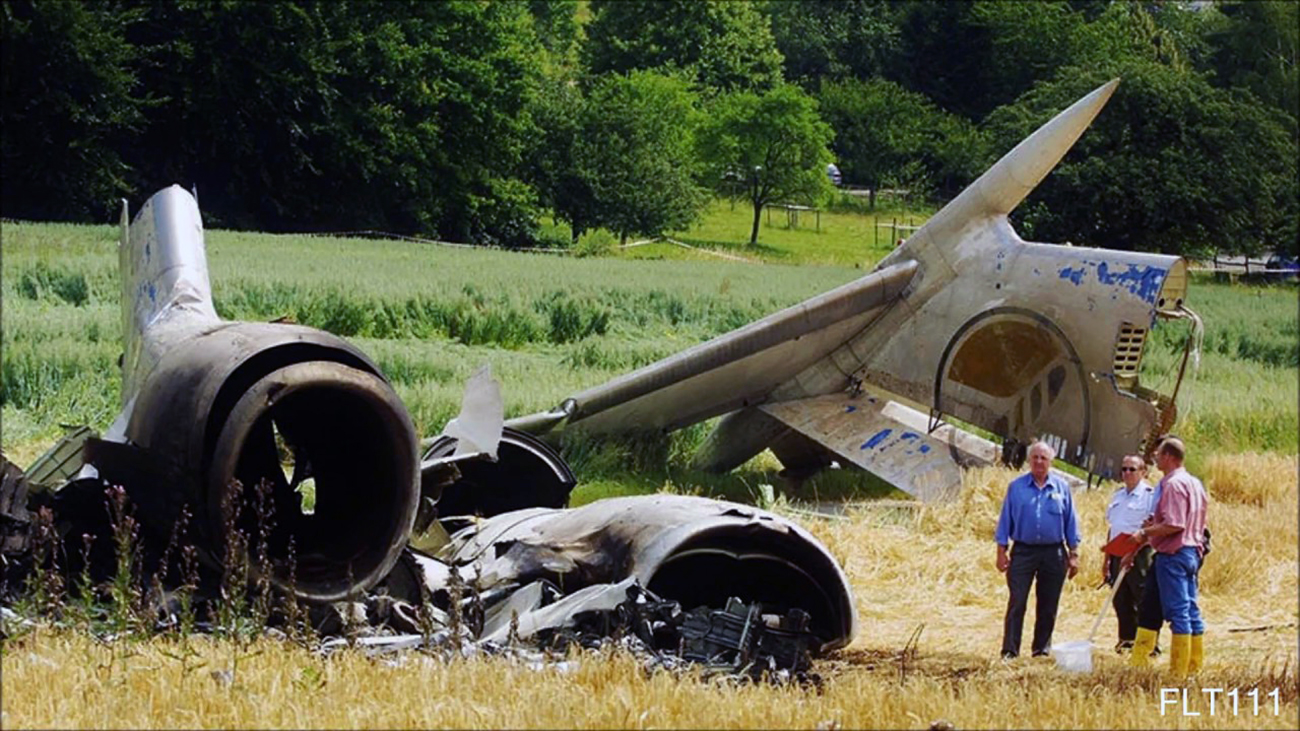

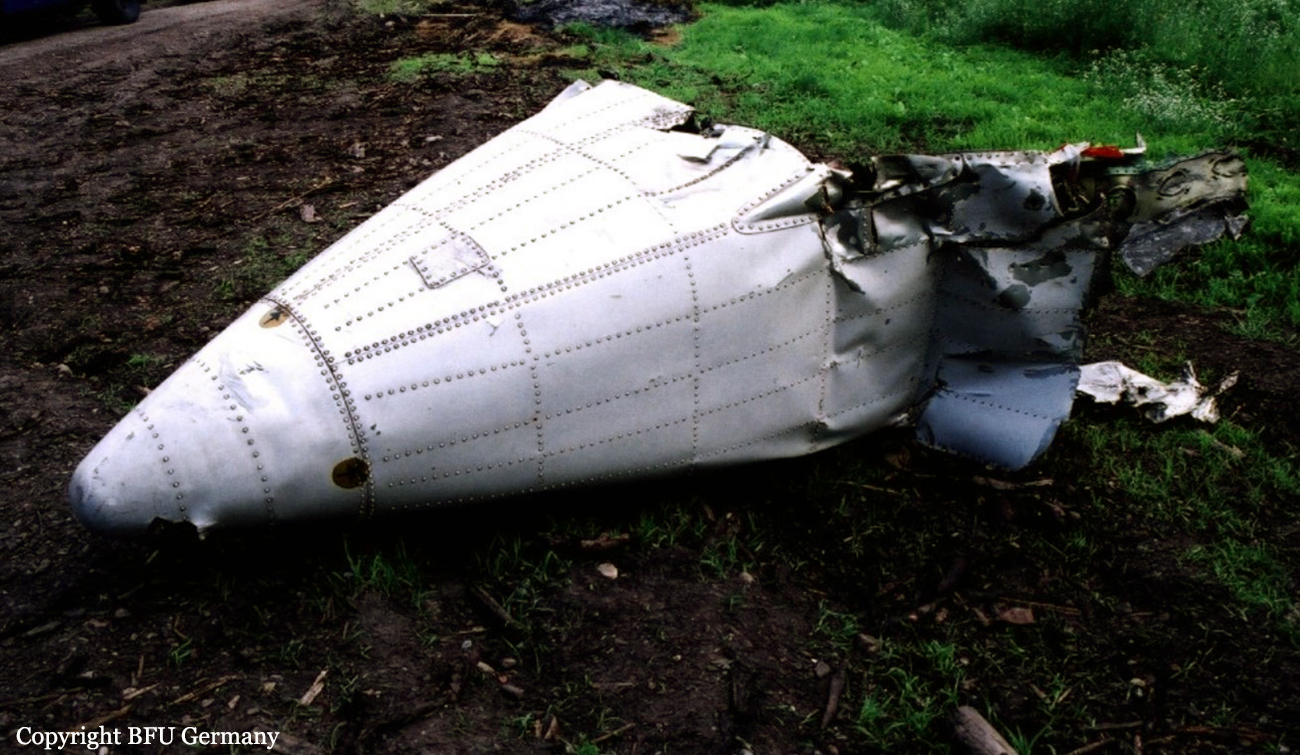
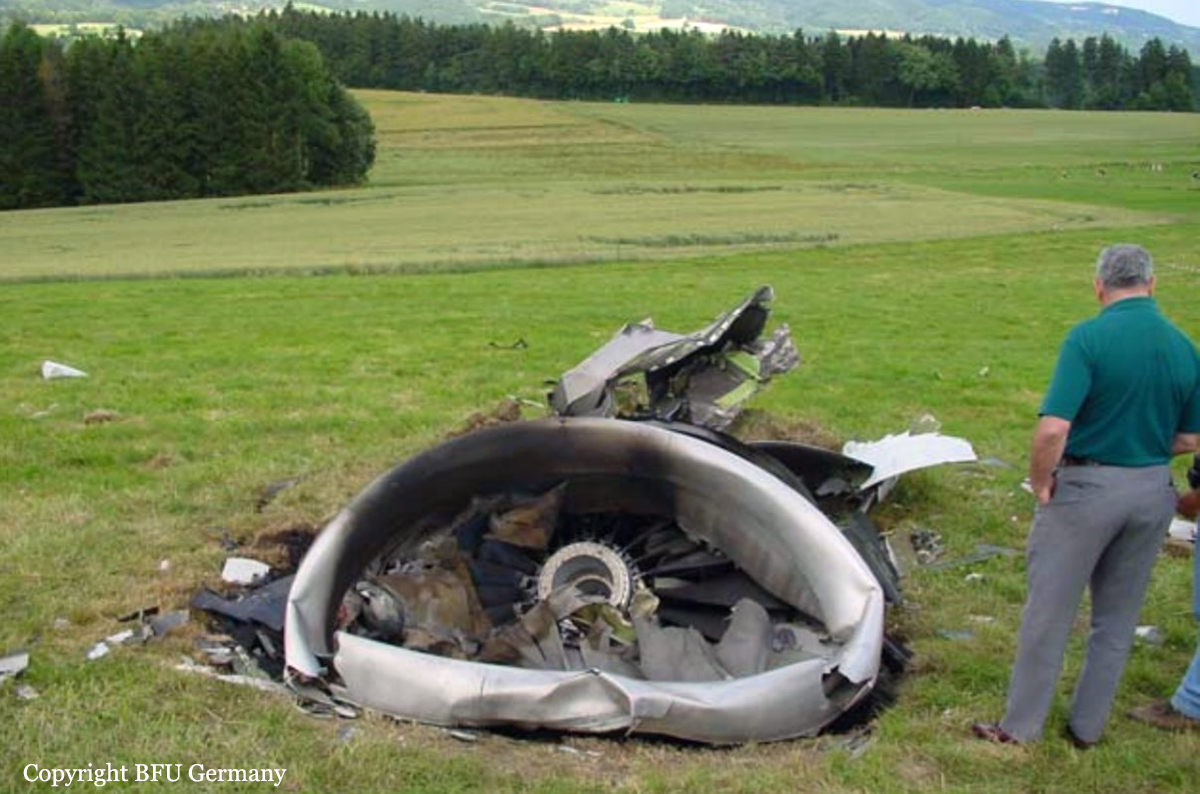
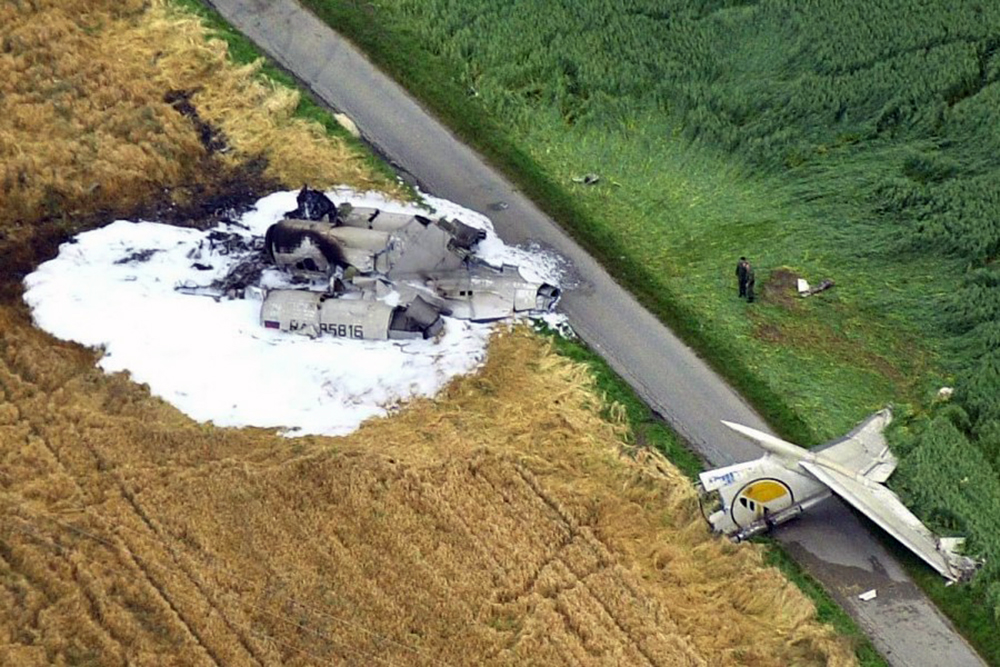


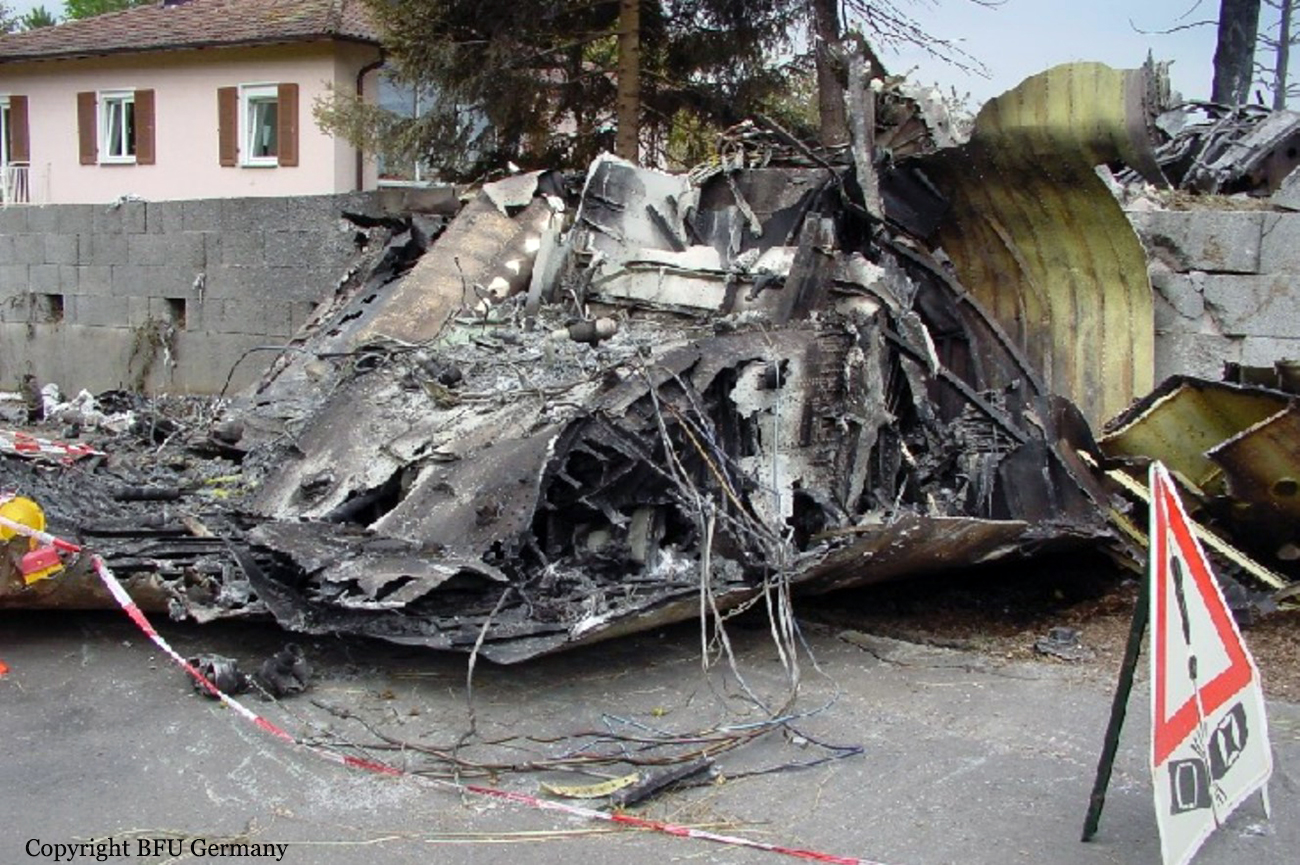
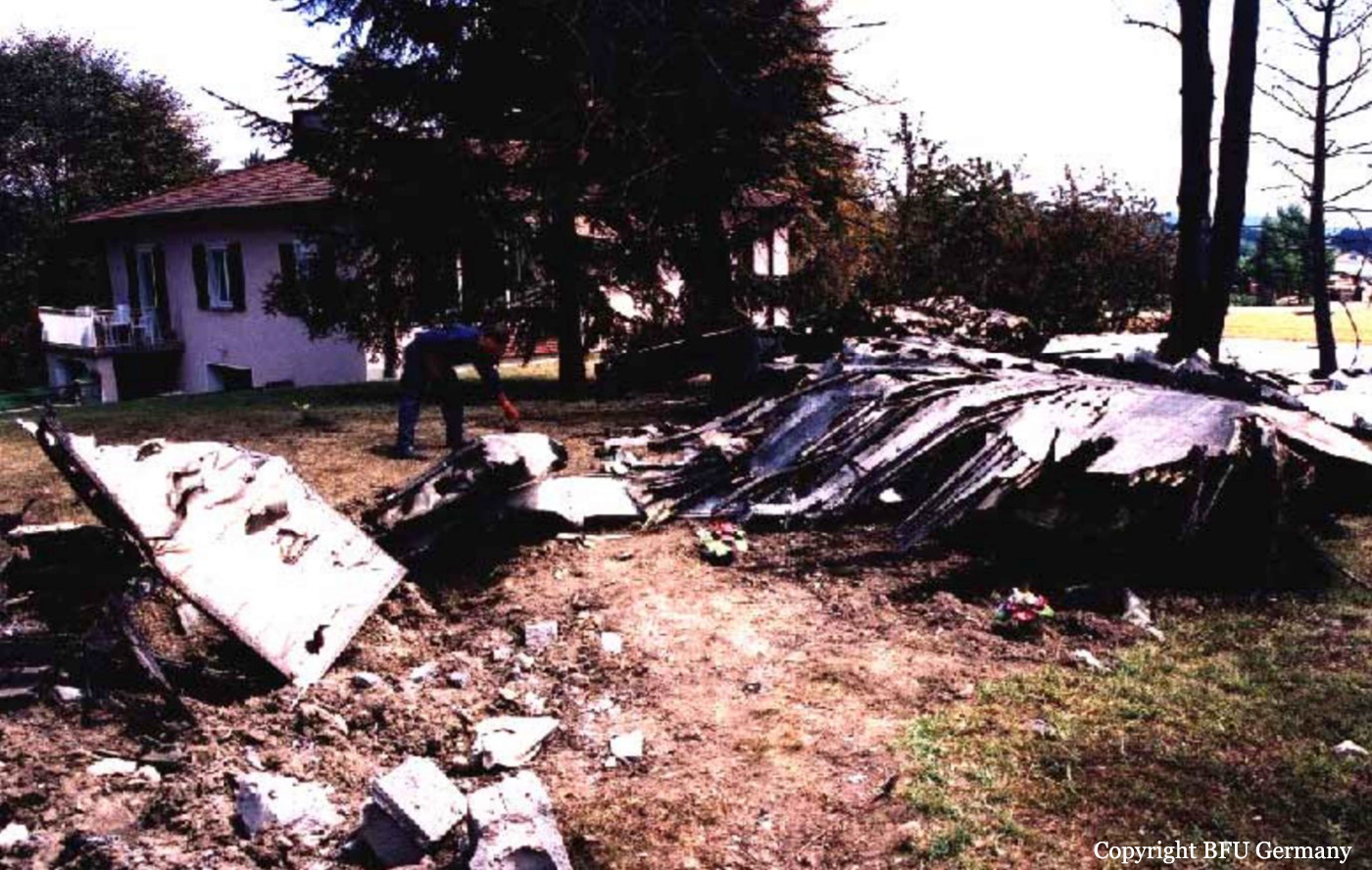

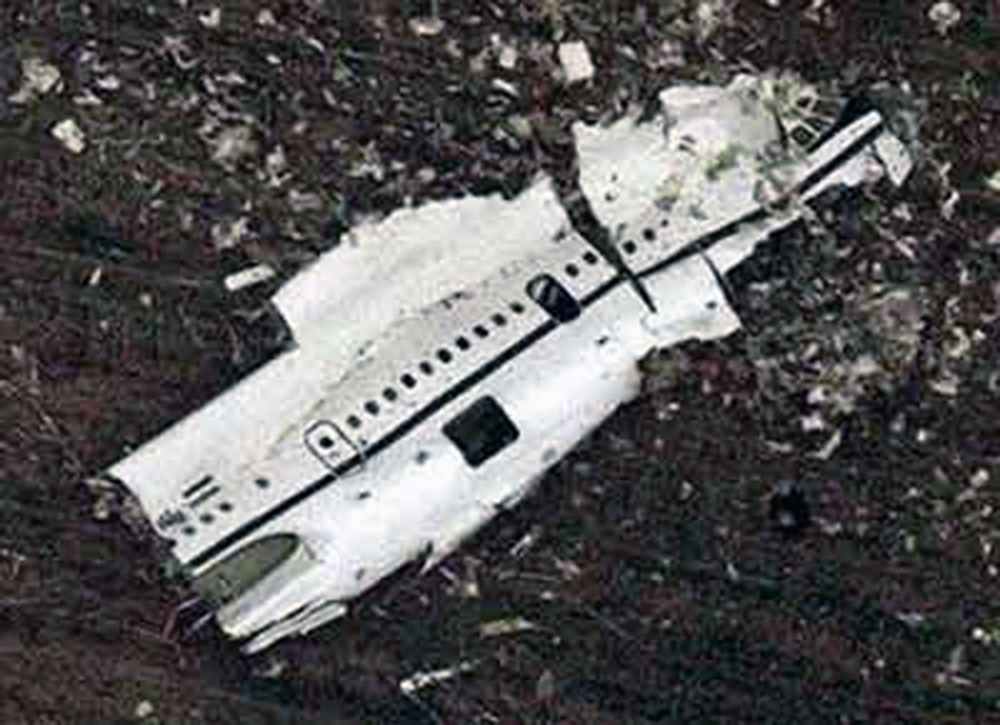

Crash of an Airbus A320-214 in Bilbao
Date & Time:
Feb 7, 2001 at 2309 LT
Registration:
EC-HKJ
Survivors:
Yes
Schedule:
Barcelona – Bilbao
MSN:
1278
YOM:
2000
Flight number:
IB1456
Crew on board:
7
Crew fatalities:
Pax on board:
136
Pax fatalities:
Other fatalities:
Total fatalities:
0
Aircraft flight hours:
1149
Aircraft flight cycles:
869
Circumstances:
The aircraft was on its final approach to runway 30 of Bilbao Airport. The aircraft, operated by Iberia, was employed on flight IB1456, a scheduled domestic flight from Barcelona to Bilbao, with 136 passengers and 7 crew members on board. The expected flight time was 53 minutes. The current conditions in Bilbao were night VMC, with a 10 knots and southwest (SW) wind and gusts of up to 25 knots. Visibility was more than 10 km and there were scattered clouds above 5,600 feet. The sun had set four hours earlier and all electronic and visual aids in the airport were fully operational. There was no rain and the flight was conducted unter IFR rules. Since the takeoff from Barcelona at 2201LT, the flight had been uneventful. The pilot flying was seated on the right hand side, and he was in line flying under supervision. The captain seated on the left hand side was supervising the flight. A third flight crew member, seated in the jumpseat, was the first officer who had given his seat to the pilot under supervision on the right hand seat. On course to Bilbao, the aircraft flew over Pamplona at FL150, where they were informed of possible light turbulence. A about 25 NM from their destination and at 7,500 feet altitude, they crossed a small cumulus with strong turbulence. Descending through 6,000 feet and established on the Bilbao localizer they found winds of 55 knots. The ATC tower (TWR) of Bilbao cleared them to land on runway 30, and informed the decision height, 247 feet, under VMC conditions and continued the approach to land. One minute prior to touchdown, the tower informed of wind conditions of 240° 8 knots. The aircraft conditions during the approach were: weight, 62,380 kilos; centre of gravity, 28,66% MAC, full flaps. The reference speed (Vref) was 132 knots and the approach speed (Vapp), 142 knots. Autopilot was disconnected by the crew at 400 feet to continue the approach manually. In the last few seconds prior to touchdown, the vertical descent speed was very high, around 1,200 feet per minute (6 metres per second) and the 'sink rate' warning of the GPWS sounded twice. The aircraft did not react to the pitch-up order input applied by both pilots on the side-sticks, due to the design software logic that operates at these specific moments, and did not flare. Announcements of 'dual-input' warning were heard at the time. Then the captain, in view of the 'sink rate' warnings, selected TOGA power setting to go around and abort the landing. The pilot's actions on the flight controls could not avoid a hard touchdown of the aircraft in a slight nose down attitude, and the captain decided to continue the landing and to stop the aircraft. The aircraft slowed-down along 1,100 metres of the runway within the paved surface. It finally came to a stop with its horizontal axis at an angle of 60° to the right of the runway centerline. During the landing roll the nose landing gear collapsed, the four tires of the main gear burst and the engine nacelles, on which the aircraft was leaning after the collapse, dragged along the pavement. Once the aircraft came to a halt, the captain ordered its evacuation, which was carried out using all the exit doors and their slides. During the evacuation a cabin crew member and 24 passengers were injured. All injuries were considered minor except for one, a female passenger whose injuries were considered serious. Seven injured people were taken to hospital.
Probable cause:
The cause of the accident was the activation of the angle of attack protection system which, under a particular combination of vertical gusts and windshear and the simultaneous actions of both crew members on the sidesticks, not considered in the design, prevented the aeroplane from pitching up and flaring during the landing.
Final Report:
